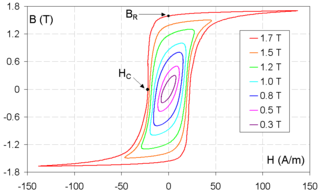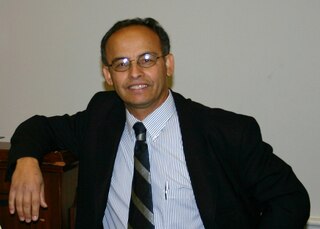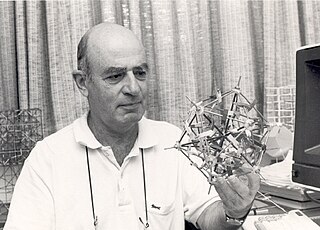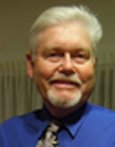
Coercivity, also called the magnetic coercivity, coercive field or coercive force, is a measure of the ability of a ferromagnetic material to withstand an external magnetic field without becoming demagnetized. Coercivity is usually measured in oersted or ampere/meter units and is denoted HC.
Micromagnetics is a field of physics dealing with the prediction of magnetic behaviors at sub-micrometer length scales. The length scales considered are large enough for the atomic structure of the material to be ignored, yet small enough to resolve magnetic structures such as domain walls or vortices.
Mark Howard Kryder was Seagate Corp.'s senior vice president of research and chief technology officer. Kryder holds a Bachelor of Science degree in electrical engineering from Stanford University and a Ph.D. in electrical engineering and physics from the California Institute of Technology.
Thermomagnetic motors convert heat into kinetic energy using the thermomagnetic effect, i.e., the influence of temperature on the magnetic material magnetization.
Spinmechatronics is neologism referring to an emerging field of research concerned with the exploitation of spin-dependent phenomena and established spintronic methodologies and technologies in conjunction with electro-mechanical, magno-mechanical, acousto-mechanical and opto-mechanical systems. Most especially, spinmechatronics concerns the integration of micro- and nano- mechatronic systems with spin physics and spintronics.
Richard J. Gambino (1935–2014) was a distinguished American material scientist best known for his pioneering work with amorphous magnetic materials.
William Fuller Brown Jr. was an American physicist who developed the theory of micromagnetics, a continuum theory of ferromagnetism that has had numerous applications in physics and engineering. He published three books: Magnetostatic Principles in Ferromagnetism, Micromagnetics, and Magnetoelastic Interactions.

Mounir Laroussi is a Tunisian-American scientist. He is known for his work in plasma science, especially low temperature plasmas and their biomedical applications.
In electromagnetism and materials science, the Jiles–Atherton model of magnetic hysteresis was introduced in 1984 by David Jiles and D. L. Atherton. This is one of the most popular models of magnetic hysteresis. Its main advantage is the fact that this model enables connection with physical parameters of the magnetic material. Jiles–Atherton model enables calculation of minor and major hysteresis loops. The original Jiles–Atherton model is suitable only for isotropic materials. However, an extension of this model presented by Ramesh et al. and corrected by Szewczyk enables the modeling of anisotropic magnetic materials.
Exchange spring media is a magnetic storage technology for hard disk drives that allows to increase the storage density in magnetic recording. The idea, proposed in 2004 by Suess et al., is that the recording media consists of exchange coupled soft and hard magnetic layers. Exchange spring media allows a good writability due to the write-assist nature of the soft layer. Hence, hard magnetic layers such as FePt, CoCrPt-alloys or hard magnetic multilayer structures can be written with conventional write heads. Due to the high anisotropy these grains are thermally stable even for small grain sizes. Small grain sizes are required for high density recording. The introduction of the soft layer does not decrease the thermal stability of the entire structure if the hard layer is sufficiently thick. The required thickness of the hard layer for best thermal stability is the exchange length of the hard layer material. The first experimental realization of exchange spring media was done on Co-PdSiO multilayers as the hard layer which was coupled via a PdSi interlayer to a FeSiO soft layer.
Evangelos Eleftheriou is a Greek electrical engineer. He is an IBM Fellow and was responsible for the Cloud and Computing Infrastructure department at the IBM Research – Zurich laboratory in Rüschlikon, Switzerland.

Shmuel (Mula) Shtrikman was an Israeli physicist, and a professor at the Weizmann Institute of Science. Winner of the Israel Prize for Research in Physics in 2003.
Anthony Schuyler Arrott is an American-born Canadian physicist, professor emeritus at Simon Fraser University. He is a specialist in condensed matter physics, physics of magnetism and liquid crystals. He is the author of over 200 scientific papers. Arrott is the subject of the 2020 documentary Portrait, directed by Lily Ekimian and A.T. Ragheb.
Susan Davis Allen is an American engineering professor and academic administrator. She is currently Associate Dean of Research for the College of Engineering and Distinguished Professor of Mechanical Engineering at Embry-Riddle Aeronautical University. Her research has spanned multiple applications of lasers and optics, including spectroscopy, laser sensors, laser ablation, micromachining, and others.

Mason Lamar Williams III was an engineer and physicist, noted for his contributions in the areas of magnetic recording and data storage on hard disk drives (HDD). A large part of his career was with the IBM Almaden Research Center in San Jose, California. After retiring, Williams played a major role in the restoration and demonstration of the IBM RAMAC at the Computer History Museum in Mountain View, California

James Nelson Benford is an American physicist, High-Power Microwave (HPM) scientist, book author, science-fiction writer, and entrepreneur, best known for introducing novel technological concepts and conjectures related to the exploration of outer space, among these the design of laser-driven sailships, the possible use of co-orbital objects by alien probes to spy on earth, and the appraisal of technical and safety issues associated with the Search for Extraterrestrial Intelligence (SETI). He was born in Mobile, Alabama in 1941, as was his twin brother, science-fiction author Greg Benford.

Robert E Fontana is an engineer, physicist, and author who is noted for his contributions in the areas of magnetic recording and data storage on hard disk drives (HDD) and on digital tape recorders. His work has concentrated on developing thin film processing techniques for nano-fabrication of magnetic devices including Giant Magnetoresistance read heads now used universally in magnetic recording. Much of his career was with IBM in San Jose, California. He is a Fellow of the Institute of Electrical and Electronics Engineers and a member of the National Academy of Engineering.

Michael L. Mallary is an engineer, physicist, inventor, and author who is noted for his contributions in the areas of magnetic recording and data storage on hard disk drives (HDD). His work has concentrated on developing and optimizing magnetic components to maximize data storage density. In particular, he is responsible to inventing the 'trailing-shield' write head used universally in modern HDDs. Mallary is a Fellow of the Institute of Electrical and Electronics Engineers and recipient of the IEEE Magnetics Society Achievement Award.

Neal Bertram is a physicist noted for his contributions to the theory of magnetic recording. From 1968 to 1985, he worked for Ampex Corporation in Redwood City. From 1985 to 2004, he was an Endowed Chair Professor at the Center for Memory and Recording Research (CMRR), University of California at San Diego. He is the author of the book "Theory of Magnetic Recording". He is an elected Fellow of the Institute of Electrical and Electronics Engineers. In 2003, he won the IEEE Reynold B. Johnson Information Storage Systems Award.
Albert Smiley Hoagland had a long career on the development of hard disk drives (HDD) starting with the IBM RAMAC. From 1956 to 1984, he was with IBM in San Jose, California, and then, from 1984 to 2005, he was the director of the Institute for Information Storage Technology at Santa Clara University. He wrote the first book on Digital Magnetic Recording. Hoagland played a central role in the preservation and restoration of the IBM RAMAC now displayed at the Computer History Museum, Mountain View, California. He died in Portland, Oregon, on 1 October 2022.








